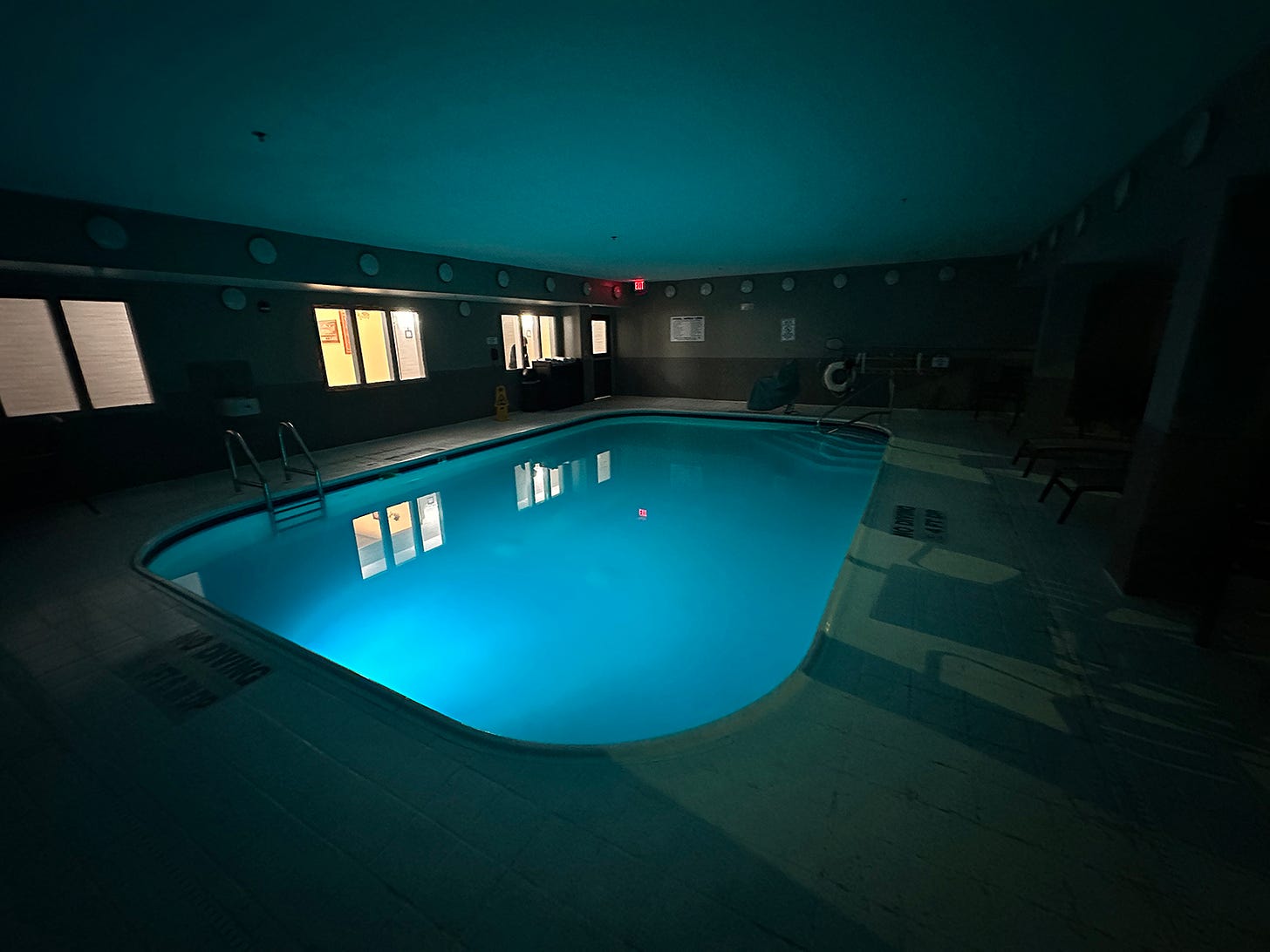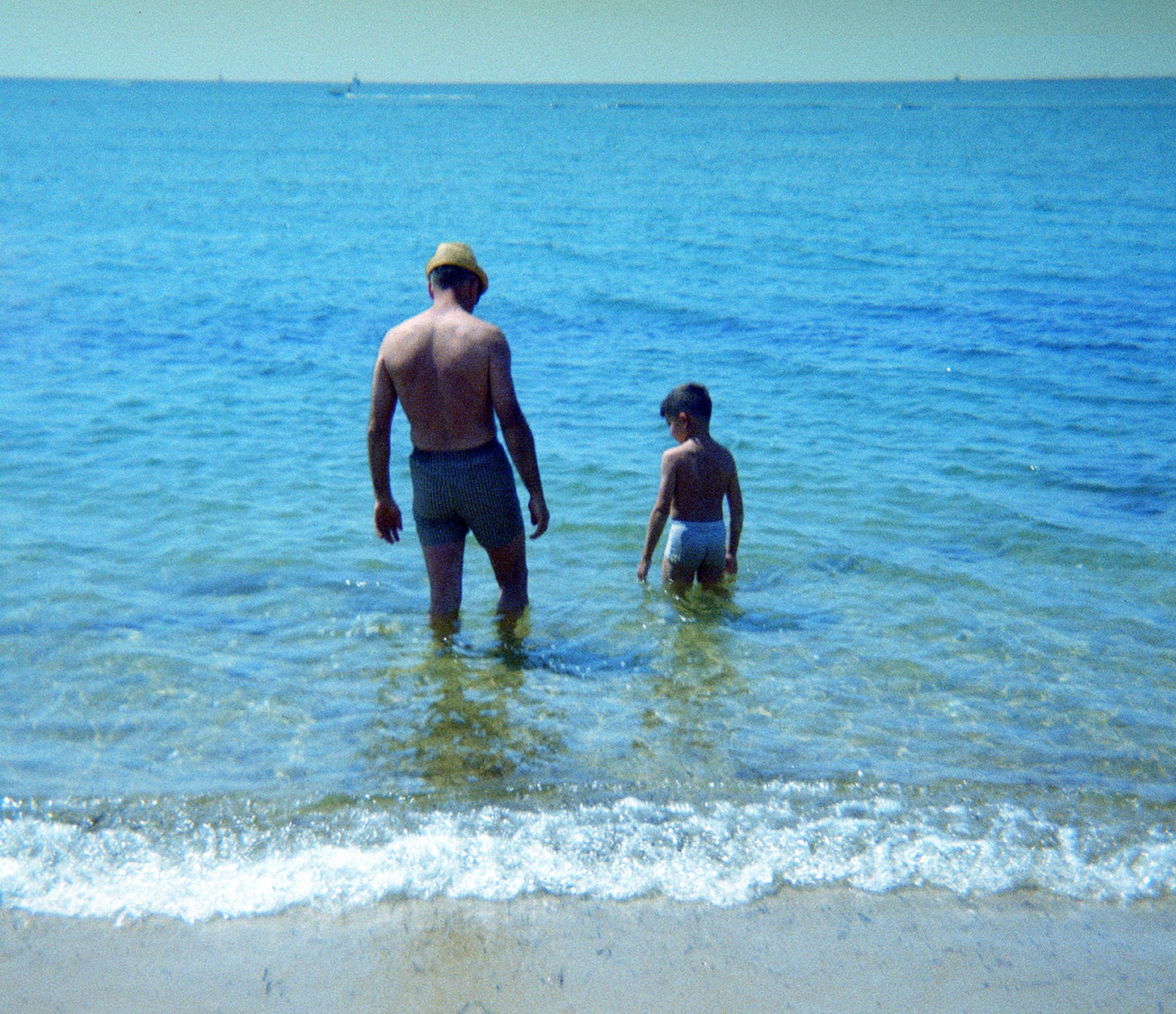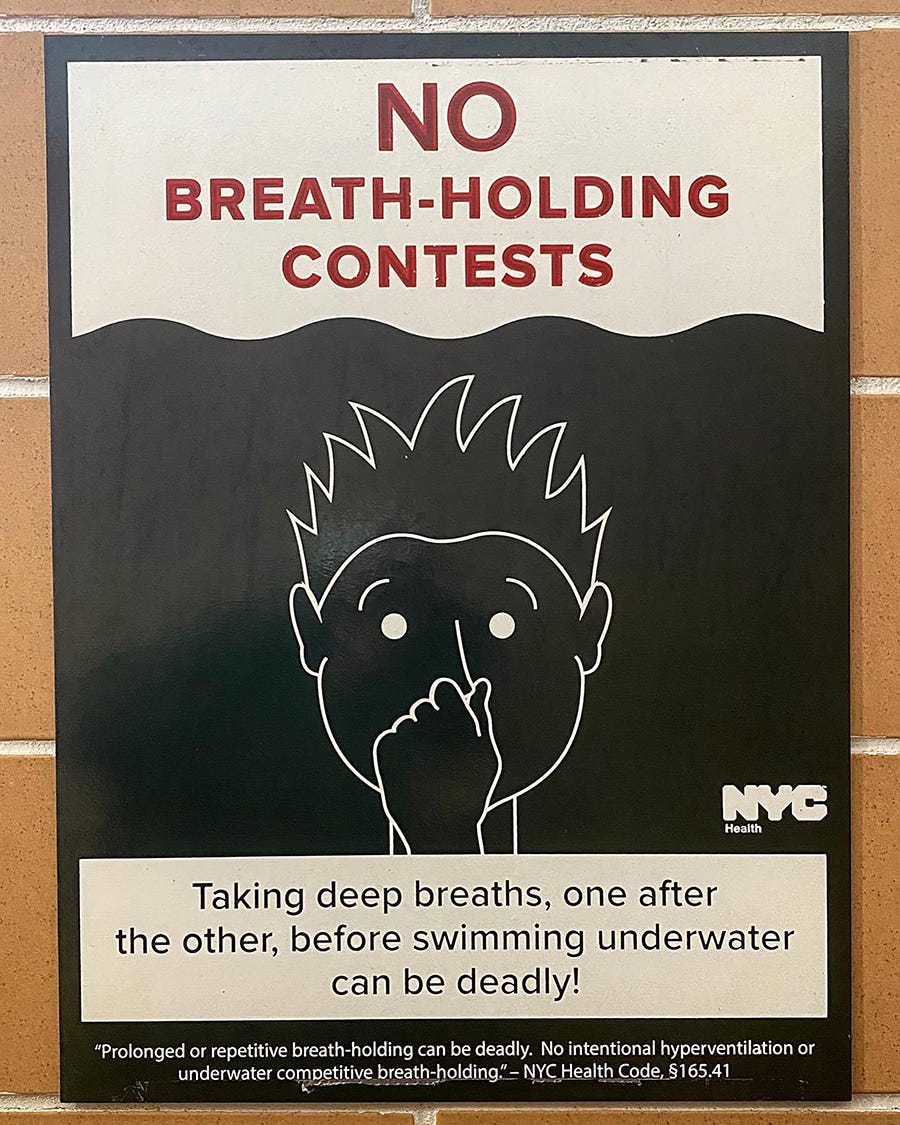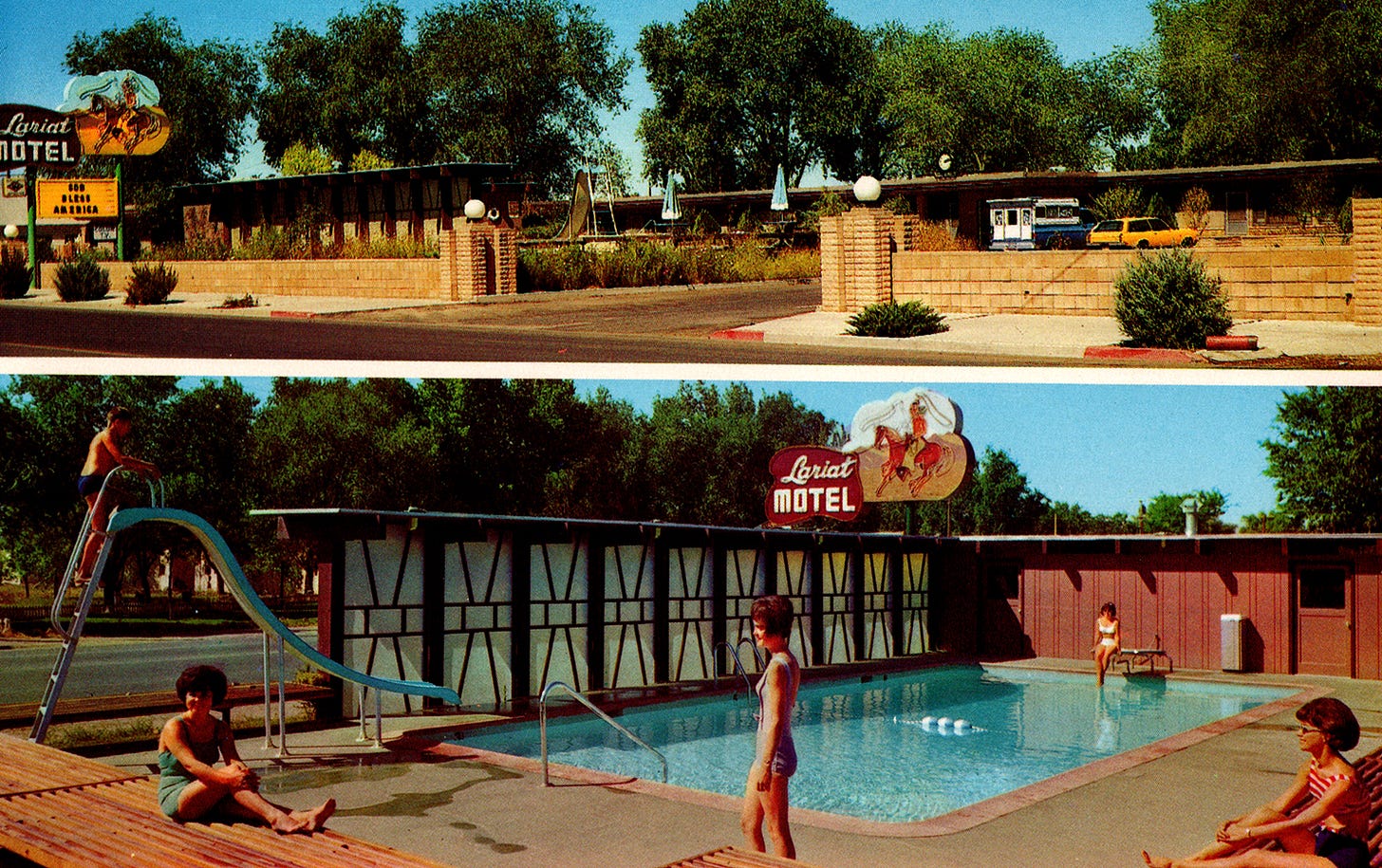I swim the slow lane at the city pool. The city pool, where Band-Aids fall slowly to the bottom and stay there for weeks. Where we all leave our towels on the long, tiled bench against the wall, flip flops just below. Where we have conversations with the occasional stranger at the end of the pool and glance at the lifeguards in safety orange as they walk by slowly, making an endless circuit around the water until they sit down and twirl their whistles in the air on lanyards.
Where people behind the foggy glass way up high in the lobby stare down at bodies in the water. Where the locker room is a miniature of the struggle that goes on every day all over this city. The guy with the hunched back, folded over forever, packs and repacks his shopping bags that hold smaller bags full of old food. Another guy spreads out newspaper on the ground and has his own tiny beach. Somebody sits on a white plastic bench in one of the showers and gets something he can’t get at home or on the streets - hot water pounding down for 20 minutes straight. I change my clothes slowly. Sometimes I wear my swim trunks under my pants. I close the locker, pee at the urinal, rinse off quickly, then walk down the hallway, past the huge blower fan, and push on the stainless steel door into the pool. I’m not there to compete with anyone.
I used to ride my bike fast for pure joy and escape. The bike was what they called an “English racer,” and I had rebuilt it with my own hands from the frame up. It was a machine that ran perfectly and silently and I rode all over the city - from the top to the bottom. I would take the ferry to Staten Island and ride to South Beach, then to Tottenville, then back to the ferry and home. I dressed in cutoff shorts and a shirt and did not look like a serious biker. When the biking jocks in their spandex and special shoes with clips would pass me on their expensive bikes, I’d hang back for a second while they went by, then turn on the heat - I had powerful leg muscles - and blow past them. They had not known they were in a race. I did it because I could - for the sheer joy of feeling my own strength. Some of these riders took me up on it. Others must have wondered what was going on.
I never had such encounters in the pool. I was never a fast swimmer. I have trouble getting into the water. I’ll squat at the edge of the pool for a long minute and contemplate the cold I am about to feel when I fall in and start to swim. I think too much and future-trip about how cold the water will be. After a minute, after contemplating the failure of not swimming, I push my body in and begin to lumber down the lane, if only to warm myself up. I’ll do two hard laps, freestyle, then flop onto my back and kick my way to the other side and breathe. I’m not racing anyone here, except possibly myself. In fact, I have to watch that I don’t clog up the works for the old ladies who swim faster than I do.
I learned to swim at the YMCA in Princeton, New Jersey. We lived there for a couple of years when I was young. My dad taught me. He had put himself through college with a swimming scholarship and he liked being in the water. He taught me what he called “the dead man’s float.” I would just lie there and I suppose the goal was to show me that my body floated on its own. After that, he taught me to kick, then to stroke with my arms. Finally, he taught me how to breathe while swimming. I hope he found some joy in these lessons. He probably did. He was a busy guy, but he devoted his few off hours to showing me how to swim, how to ride a bike, how to use tools and helping with my joyless math homework.
I learned how to swim, but swam little for a long time. At the beach, I went into the ocean. There was a swim test when I got into high school. I passed. Swimming was not something I thought about much. In Adams House, at Harvard College, there was a decadent, gilt and marble holdover from the first Gilded Age - a small indoor pool - and some of us would get high and then go swimming, floating, splashing in this Victorian-era pool late at night. I didn’t do laps. I did Quaaludes and just stayed afloat. There was little swimming for the rest of the 1980s. When I cleaned up my act at the end of the decade, it was bicycling that saved my ass, as it had for my whole life. Long solo bike rides all over New York City, racing others and racing myself.
At some point in the mid 1990s, I was newly divorced and cut off from much of the life I had fashioned for myself. I was living on Barrow Street, just off Hudson Street, 10 blocks south of where I had lived with my wife, in the lower part of the West Village. I was trying to get into shape. I was not in bad shape, but I felt the need for order and unwittingly created a boot camp in my head. When I wasn’t working or trying to get laid - and I usually went home alone - I was writing madly and starting to exercise at home - chin-ups, sit-ups, pushups. It was a cold winter one year and I read about the Tony D’Apolito Recreation Center, just a short walk downtown on Carmine Street.
I had never swum for exercise before, so I didn’t know what to expect. I went down to the ancient brick building and joined for a year. At the time, it was 25 or 50 bucks for the whole year, I don’t remember. Somebody gave me a 5-minute tour of the facility. It was straight out of the 1930s. There was a weight room inside a tremendous metal cage right off the floor of the basketball court. Above the court was a banked running track that went around the whole building. In each elevated corner of the track was a primitive rowing machine, with rusty cables and a straight steel pipe for a hand grip.
The locker room was on the ground level. After I showed my card and my padlock to get in, I went to the locker room, where the strong smell of chlorine hit my nose. A few guys were sitting around on the benches, either changing or staring at the floor, and I found a locker, then began to undress. I got my suit on, locked the locker, then walked to the door of the pool in my flip-flops. I took a long breath and pushed the door open. It was a tiny universe in that pool, with a high ceiling, splashing noises, dim lights and steaminess in the air. I hung my towel on an old hook, left my sandals below it, then went to the pool. It was 23 yards long and had three lanes, but there were only a few people there.
Somebody was in the lane on the right, which I would discover was the fast lane. That was for serious swimmers. Two people were in the middle lane, going in regular, even, counter-clockwise loops. The lane on the left had an old lady on her back, slowly kicking away. I could smell strong perfume from her direction. She wore some kind of skirt-like swimming getup that was out of the 1920s. I didn’t want to disturb her, so I stood at the end of the middle lane and got myself ready. There was a lifeguard at the far end, in the corner by the door to the outdoor pool. He was sprawled in an old office chair and may have been asleep.
I have always hated getting into the water, those first few minutes of being cold, so I stood there for a long moment and then said “fuck it” to myself and hopped in. The shallow end was really shallow, so there was no diving in. There were also signs that said “NO DIVING” and they were next to signs that warned against not adding blood, mucous, fecal matter or anything else to the pool. “No swimming with open wounds” and some other healthy exhortations. There was also a graphic that said “NO BREATH HOLDING CONTESTS.” I hopped in and the first impression was happy - the water was warm. This was great. My outlook improved and my shoulders fell. I had not been swimming in a long, long time, but I was ready for it now.
I timed my lap for when the whole lane ahead of me was empty - the two guys were on the return trip - and I just started out. Old muscles kicked in and it felt good. I was young and in shape, but not for swimming. I swam in long, skinny circles for 15 minutes and was almost gasping for breath. I got out and headed for the shower room, which was a square, tiled communal area with 5 shower heads coming out of three walls and a drain in the middle of the floor. I stood under the water for a long time, then went to my locker and changed clothes. There were kids all around who had just gotten off basketball practice, older guys who had been swimming, and local homeless people who were there simply to clean up.
I walked home feeling stretched-out and loose. I was working all day at a bakery and was about to quit and start to hustle as a freelance writer. My social life was thin and I spent most of my time tromping around the Lower East Side, hanging out in the aisles of Tower Books and Saint Marks Books, eating pizza and then going home. The Carmine Street Pool became my oasis. I went religiously, three times a week and my swimming improved. I’d mainly stay in the middle lane but, if it filled up and got too congested, I might slip under the ropes and freestyle hard in the fast lane. I could usually keep up with the fast swimmers. When I needed a break, I swam underwater through the middle lane and into the slow lane which, for reasons I don’t recall, I called “the lounging lane.”
The lounging lane was where you could float on your back and slow kick from end to end. The lounging lane was calm. You could do pull ups at the deep end of the pool, off the tiled edge by the ladder. Some people stretched at the shallow end and you could just swim around them if you were doing laps. The Carmine Street Pool was fairly warm and most of us liked it that way. An occasional Spartan type would complain that it was too warm, but we’d all shout them down and tell the lifeguard it was fine. I don’t know who had control over the temperature, but a thermometer hung by a rope in the water at the deep end and I would check it regularly.
When I finished swimming, I’d throw on some shorts and go upstairs. The old, Great Depression-style weight machines were never my thing, but I loved sitting at one of the equally ancient rowing machines and pulling hard on the cable. High above the basketball court, I would just sit in my corner and row and watch the different teams practice. When I finished, I’d run down those skinny old stairs, change into my clothes and go home. The whole facility became my refuge. The pool, especially, was a sanctuary. On freezing days, it was warm and steamy and lit up all green and blue. That pool saved my life during a tough time.
Once in a while, some college-aged swimmers would find out about it. They would come into the slow or medium lane and swim like they were at the Olympics until someone told them to cool it. There were plenty of strange characters - people who seemed to wander in from another planet, swim for 15 minutes, then disappear. I’d imagine cabbies parking outside and running in for a few laps. It was an egalitarian arena of young and old, strange and forgettably normal, odd bodies, beautiful bodies, people just hanging on to life and others for whom the pool was part of a daily ritual that went back decades. Everyone there needed to be there. It was not the French Riviera and the shower room was not the Russian/Turkish baths, over on the east side of town. It was not the Adams House pool, in what used to be called the “Gold Coast” buildings in Cambridge. But water is water and humans are humans.
I kept my membership for many years, even after I moved 10 blocks north, back to the street where I had lived in my 20s. I wasn’t swimming much and, at some point, I drifted away completely. It was a busy time and my life had gotten full. I was biking a lot, but not swimming. I was teaching and working at freelance jobs. Every chance I had, I’d hit the road and drive around the country taking photos, soaking in hot springs, eating weird food in small towns and taking my time. Always in the back of my mind, though, was the city pool, the place that had saved my ass.
Friday is Part Two…
All photos (except the postcard) by Paul Vlachos.
If you enjoyed this post, hit the ♡ to let us know.
If it gave you any thoughts, please leave a comment.
If you think others would enjoy it, hit re-stack or share:
If you’d like to read more:
And if you’d like to help create more Juke, upgrade to a paid subscription (same button above). Otherwise, you can always help with a one-time donation via Paypal or Venmo.








what a special place, beautiful piece, Paul.
Thanks for this, Paul. Those pieces where the personal meets place, or perhaps it is the exactness of place, that makes the story memorable, and by story, of course, I mean your story. The intentionality is genuine.